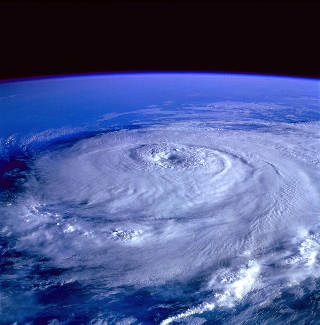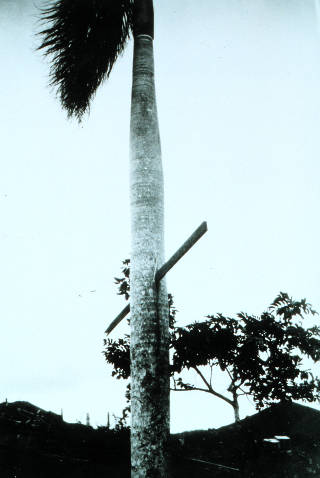Hurricane Elena was responsible for the best meal I had as a college freshman. The 1985 hurricane skirted the Florida State University campus, taking down trees and utility lines before making landfall near Biloxi, Mississippi. A local grocery store lost power and had to give away the stock of meat it couldn’t refrigerate. So my friends and I gorged ourselves on grilled steaks!
We were very fortunate—Caribbean hurricanes can pack tremendous destructive force. They are often terrifying and frequently deadly. In 1772, Alexander Hamilton while living on St. Croix eloquently described the impact of a major hurricane. Young Hamilton survived this encounter and went on to become the first Secretary of the Treasury of the United States.
 |
| Hurricane Elena photographed from Space Shuttle Discovery, September 1, 1985 |
Though the 1772 hurricane terrified Hamilton, many historians have generally ignored weather events, along with larger climatic patterns, geologic disasters like earthquakes, and outbreaks of disease as unimportant to historical scholarship. They looked at human events as only having human causes and discounted the possibility of other factors having a significant impact. But in recent years, historians have started to seriously consider how non-human forces have shaped historical events and trends. Two impressive examples are: Climate Change and the Course of Global History: A Rough Journey by John Brooke and Global Crisis: War, Climate Change and Catastrophe in the Seventeenth Century by Geoffrey Parker.
In Sea of Storms: A History of Hurricanes in the Greater Caribbean from Columbus to Katrina, author Stuart B. Schwartz is fundamentally inspired by a historian from an earlier generation, Fernand Braudel. In Braudel’s magisterial study, The Mediterranean and the Mediterranean World in the Age of Phillip II, first written during the Second World War, he explores humanity’s experience in the Mediterranean region over centuries across national and continental boundaries. Braudel conceived people and historical events as being profoundly shaped by the temperate, predictable Mediterranean climate.
Schwartz, like Braudel, explores an expansive geographic area, crossing political and cultural boundaries, over a span of centuries. But where Braudel saw climate and weather as stable and benign, Schwartz emphasizes the unpredictable but potentially devastating impact of Caribbean hurricanes.
Over a long and notable scholarly career, Schwartz has written and edited numerous books on the history of Latin America and Brazil especially as they were shaped by Spain and Portugal through exploration, trade, warfare, and colonization, including Africa, South America, Central America, the Caribbean, and parts of North America.
In Sea of Storms, Schwartz defines the “greater Caribbean” as extending from South America, westward to Mexico, and north as far as the Chesapeake Bay on the east coast of the United States. Throughout this vast region, he emphasizes two themes that have had long-term influences: the enduring legacy of plantation slavery leading to economic development at the cost of tremendous human suffering and the major role of the United States as the regional superpower starting at the end of the nineteenth century.
Through the five centuries covered by the book, people’s perception of what hurricanes signified changed drastically. From the time of the Spanish conquest of the region, beginning in 1492, through to the 1700s, hurricanes were seen as God’s wrath unleashed upon sinning humanity. Prayer and fasting were means to bring divine favor and protection from storms. The shift to a scientific understanding of hurricanes started around 1700 when people began precisely measuring and formulating theories about them.
The modern system of measuring storm intensity on the category 1 through 5 scale was not developed until the 1970s. Thus historians depend largely on subjective reports of damage to estimate the intensity of earlier storms. In past centuries, many of the fatalities caused by hurricanes did not result directly from wind and storm-surge damage, but came about later due to starvation, thirst, and exposure. This was especially a problem on smaller islands where a single storm could wipe out major elements of the infrastructure for providing food, drinking water, and shelter.
The question of how societies and governments respond to disastrous hurricanes is central to Schwartz’s study. Self-help, religious and secular charities, and government assistance have been employed consistently throughout the period to help people cope with catastrophic events. Varying factors have shaped relief efforts. These include technical capacity, economic resources, and ideology. Different attitudes towards the role of government sharply define the most recent chapters of the book. During the Cold War, the way different nations responded to hurricanes were used by Cold War foes to score propaganda points.
| Ciclón, Santiago Álvarez’s documentary on the Cuban response to 1963 Hurricane Flora, available via YouTube. (Images of death and suffering may be disturbing to some viewers). |
Schwartz attempts to integrate the experience of ordinary people into his story. But he struggles to cope with the challenging fact that slaves, peasants, and the poor have left very little in the way of historical documentation. So his story tends to emphasize the literate elites, charitable institutions, and government agencies, because these actors have left rich sources of evidence.
Schwartz does an outstanding job of balancing attention between earlier centuries and the contemporary period. He also demonstrates his historical range and linguistic capabilities by integrating evidence from Spanish, Portuguese, English, and other languages. This is absolutely vital given the diverse cultures that are all part of Caribbean history.
In addition to its emphasis on hurricanes, and how humanity has responded to them, Sea of Storms also provides a useful general summary of the history of the Caribbean. But for many readers, Schwartz’s concluding discussion of current storms and policies is likely to be the most interesting part of the book. He points out that FEMA (the Federal Emergency Management Agency) was hampered by both budget cuts and a refocusing of its mission towards anti-terrorism prior to the Katrina disaster. He also looks at discussions of how human-caused climate change may influence the severity, frequency, and geographic reach of hurricanes.
Discussing the possibility that human-emitted greenhouse gases may be altering hurricane patterns allows Schwartz to bring his story to a full circle. Five centuries ago people saw hurricanes as divine punishment upon sinful humanity. Now, we are again bearing some responsibility for hurricanes through our pollution of the atmosphere.
The 2015 Atlantic hurricane season starts on June first and runs through the end of November—stay tuned and stay safe!

